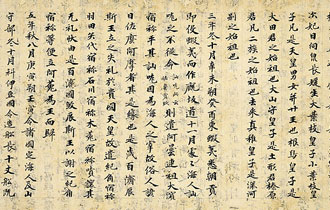Pages |
The garden was begun by shogun Ashikaga Yoshimitsu in 1391 when he transformed the Kitayama Villa located in Kyoto's northwestern hills into a lavish retirement residence. After his death, the complex became a Buddhist temple. The main attraction is a three-storeyed pavilion built in a general Chinese style, but without the usual elaborate bracketing, tile roof, and round columns. Rather, the roof is native shingle, and the whole is constructed with squared timbers and plain surfaces of natural wood. The pavilion is set on a man-made platform jutting out into the pond and surrounded by pines and deciduous trees all carefully planted in "natural" profusion to show seasonal changes in foliage to the best advantage. The pond is divided into two parts by a large peninsula. Both portions of the pond feature small rock islands that are artificially placed but appear spontaneous and natural. The smaller section of pond contains rocks often characterized as a crane-shaped island and two turtle islands; the larger section contains a few small rock islands that suggest we are viewing them from a great distance. It has been suggested that the intent of this garden layout may have been to create for the views an enjoyment of ocean scenery reminiscent of that seen on an excursion along the coast of Japan.
But what stands out in the natural environment is the brilliant gold leaf covering the roofline of the pavilion, most of the exterior, and parts of the interior. Although no other building in Japan is gold-covered in this manner, the concept is reminiscent of another residence-turned-temple: the twelfth-century Byōdōin (Phoenix Hall) located in Uji south of Kyoto. Byōdōin also has a pond-and-stroll garden that, like Kinkakuji's, was originally designed for the worldly enjoyment of its creator courtier Fujiwara Yorimichi. After his death, however, the pavilion was transformed into a Pure Land temple complete with a gilt Amida Buddha inside. The garden was likewise redesigned to recreate the Western Paradise, with a lotus pond and stands of sweet-smelling flowering trees.
Scholars have suggested that adhering gold leaf on the outside of Kinkakuji had the effect of making the building itself sacred, in the same way that placing a gilt image of the Buddha inside a temple might.
On the opposite side of Kyoto, nestled in the eastern hills, is Ginkakuji, the Temple of the Silver Pavilion. It was once part of the Higashiyama Villa begun around 1473 by the eighth Ashikaga shogun Yoshimasa (1436-1490). During the shogun's lifetime, the villa was the cultural center of life in Kyoto; upon his death it was converted into a Zen temple. The garden has two parts: a garden for strolling around a pond and a dry landscape garden. Rocks and trees are the structural elements in the stroll garden, and they are used in a relatively unaltered state in order to recreate impressions of the natural environment. Great effort is made to maintain an unintentional, uncontrived effect. Yet to be unintentional is artificial, so the designer and gardener walk a fine line between manipulating the elements and letting natural accidents happen: leaves and pine needles fall, moss grows on its own, and trees age, change shape, die, and are replaced. The gardener cannot predict such spontaneous happenings, but works with the changes toward a particular effect. This part of the garden, with its pond and islands, remains a variation on the earlier Heian prototype. The original plan even included a boathouse, which no
The dry landscape part of the garden anticipates the exclusively "dry" gardens of later times. Here for the first time, the topographical elements of ocean and mountain are symbolized solely with sand. An area of raked white sand symbolizes an open silver sea and a conical mountain of white sand recalls the shape of the most famous mountain in Japan, Mt. Fuji.
Pages |











